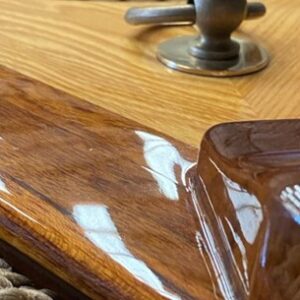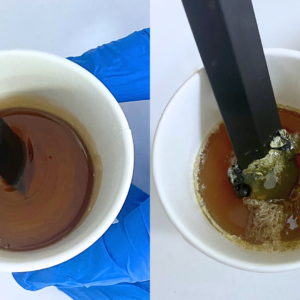How To: Looking to Start with Resin Art? A Beginner’s Guide
So, you’ve decided to give resin art a try? Congratulations, you have an exciting journey ahead of you. Check out our beginner’s guide.
From the very start, it can be easy to jump straight in without doing your research. But resin art comes with its own set of challenges and there’s a lot to learn, which can be overwhelming.
Not sure what supplies you need, let alone where to get them from? How to keep yourself safe? We’re hoping this article will help you out.
We sat down with one of our favourite resin artists, Kate Ede from The Resin Reserve (resinreserve.com), to get her advice on what you need to know before diving into the world of resin art.
Before reading this article: It is important you know the difference between terms you’ll come across often in your resin art journey. We reference the term ‘epoxy’ throughout this article.
Epoxy is created by mixing two-component, a liquid resin and a suitable hardener. ‘Resin Art’ is a term penned by those in the industry, and it is the process of creating art using epoxy resin.
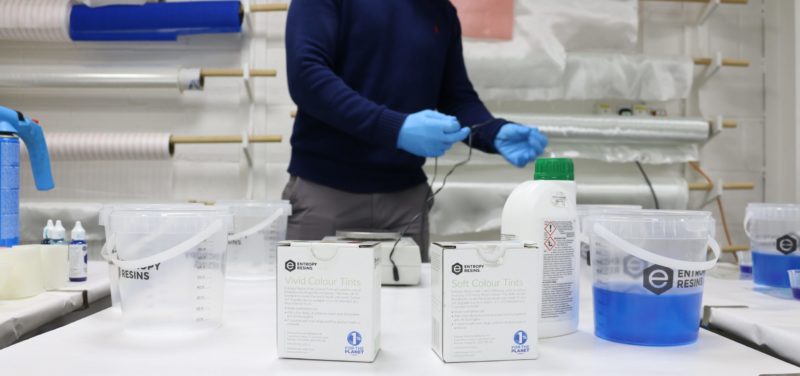
Hi Kate, why don’t you start off by telling us how you got started in resin art?
My first glimmer of resin art was through an online video of the incredibly talented and trend-setting Mrs. Colorberry pouring mesmerising, glistening geodes and it stopped me scrolling in my tracks. So much of the recent outburst in the epoxy resin crafting world should be attributed to her. I often wonder if people #geode and know it began with a little brainwave of hers that has inspired so many of us.
What safety procedures do you follow when working with resin?
Safety is a huge deal. Remember, we are working with chemicals here. I wince at people not taking it seriously. I’ve had reactions from just sheer overexposure and it’s no joke; just check out the group “Epoxy is not my friend” on Facebook.
When you pour so often it’s easy to get complacent with the PPE. “Oh, I’ll just do a little tweak of this quickly without my mask.” – Please don’t.
Beginners will need the basics:
- Nitrile gloves – absolutely. You need to protect your hands and nitrile gloves are least likely to react with your skin.
- A well-ventilated space – opening a window is an easy way to keep your space ventilated.
- Goggles – I’d recommend them for pouring and sanding. You don’t want epoxy splashing in your eyes.
- A good 3M mask or respirator (other brands are available). When sanding cured epoxy and working with large volumes of epoxy, you must wear one.
Next is the workspace. I’m not going to say people can’t work at home because thousands of people do. This is a fun hobby for most people after all, many of which were born in lockdown. But if you are working from home, I’d always advise that no one else, including your children or pets have any exposure to potential epoxy fumes. Be sure to thoroughly clean your surfaces and clothes after use and keep your workspace out of communal areas as much as possible.
My final tips are barrier cream on your forearms if you can’t cover them and if you can use a different sink to the family kitchen to wash out equipment, then this is advised.
Just make sure you do your research and work responsibly whatever your set up. It’s a lot more fun when you know you’re keeping yourself and others around you safe.
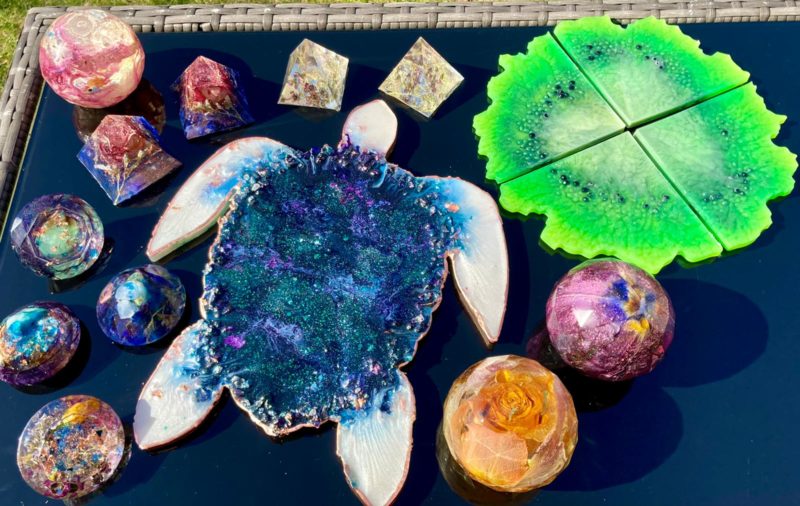
How do you prepare your work area before you start on a project?
I have a general setup that stays in place so I’m ready to work when I walk in the room, but I clear out and re-set up regularly as mess and chaos erupt very quickly.
Because I’m an organised nerd, I do sessions where I clean all my silicone jugs and moulds, dispose of and then relay the plastic sheets etc.
Here are the things I find noteworthy:
- My heat gun stays on a slate slab at all times when not in use, away from everything else.
- I have silicone mats that are a god send, it cuts down wastage and saves cleaning time.
- My moulds are stacked in cupboards flat as this ensures their longevity.
- I organise my stones, glitters, leaves, pigments and inks. Not only because we all get satisfaction out of our collections, but if your epoxy is curing fast and you are searching for one tiny item you’ll thank yourself for that organisation.
But my most important set up tips are:
- A clear, open and level space for measuring and mixing because you will have clumsy moments.
- Your working and drying areas need to be level in every possible direction. One of my most disappointing moments remains the time I found my perfect pretty orange on canvas had slid off into a nice pile on the floor. Top tip: big spirit level and tiny spirit level!
- My other ‘couldn’t do without’ are these trays with lids that I put my smaller moulds in and then can move around to drying racks, swap in and change with every session. You will only try carrying a full mould once.
What key supplies do beginners need before they start their very first project?
- Personal Protective Equipment (PPE)
- Resin and hardener
- Heat gun (or small blowtorch if working very small items)
- Whatever bedazzlements you like: pigments, glitter, inks, stones
- Moulds (nothing will clear out your bank account quicker)
- Plastic sheets to protect your work surface
- Measuring scales or jugs
- Jugs / spatulas / stirrers / cups for mixing
- Consider something that covers your creations during curing
Where do you purchase your supplies?
- Resin and Hardener: Entropy Resins
- Moulds: I highly recommend finding your favourite independent mould makers on social media. This is also the biggest plus of joining groups on Facebook etc. All the typical moulds can be found on eBay, Etsy, Wish, Amazon, & Aliexpress. Aliexpress is undoubtedly best on price yet shipping from China can take a long time, so I like eBay as a happy medium. I’d say the most unique are on Etsy.
- Supplies: I’m an eBay fan for my standard supplies but you will have lots of fun looking for glitters, or even treating yourself to some Colorberry exquisiteness.
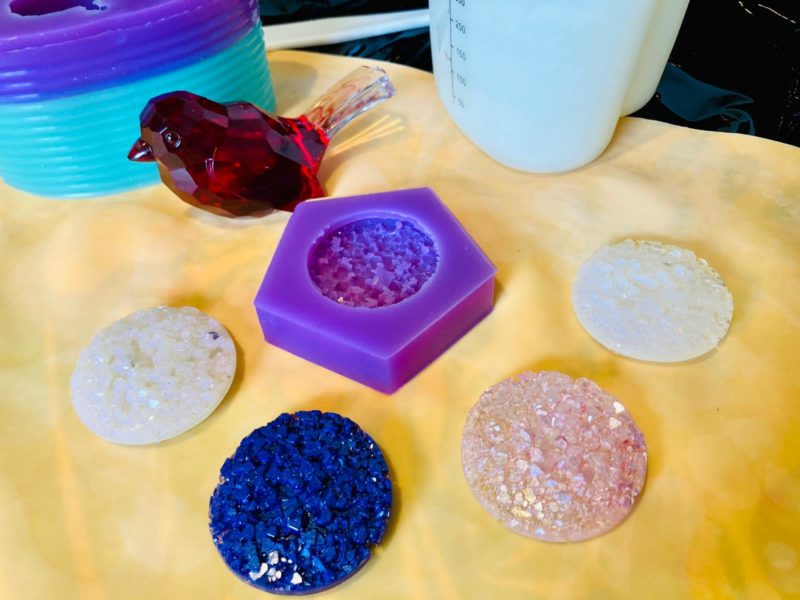
What are good starter moulds for a beginner?
A variety is always best. Obviously, it depends on what you are keen on trying, but if you want to learn all round skills to really control, perfect and manipulate your materials, I’d recommend:
- Teeny Tiny Moulds: It actually takes a lot of skill to work in such a tiny space. I love that Epoxycraft’s Emily started with bookmarks, I’ve never tried them myself and they look awesome.
- Casting Moulds: Something like a teddy bear mould will teach you about depth effects or by using a feather trinket dish you will learn about working with certain techniques upside down.
- Pyramids: These will help you master layers, patience, eradicating bubbles and how to see the bigger picture of a project. If you’re a total beginner, start with the smaller pyramid moulds.
If you have the goal of selling your creations, ask yourself, what is going to be popular within your personal interests?
What mistakes did you make at the beginning of your resin art journey that you have learned from?
- Not mixing thoroughly enough and for a long enough time. I now mix for ages, and then I’ll go back and mix some more!
- Not measuring precisely enough. We all get over excited at the beginning, but take your time to get it right first time.
- Not working on level areas (see previous orange anecdote).
- Taking things out of the moulds too soon. Impatience is a killer. Even after the you think things are hard to the touch and therefore cured, always assume you are wrong or suffer a very bendy, impractical serving tray.
Can you give us your top 5 tips to working with epoxy?
- Research. The resin journey is trial and error and often we only really learn from getting a feel for it and actually making those mistakes. But there are thousands of videos and tutorials on YouTube so save yourself time and money and watch everything you can – and get inspired and excited along the way
- Patience. You will have no choice but to obtain it. Trial and error again and again.
- Really know your materials, especially your epoxy resin and hardener. For example, how long to leave your epoxy to thicken up enough to create the best patterns or to perfectly suspend your inks. The main question beginners ask is “why is my glitter sinking?” It’s the difference between chunky glitter sinking to the bottom or fine glitter rising to the top. Once you know your curing times, you’ll learn when the best time is to do certain techniques.
- Whether you are doing it for a fun hobby or to start a small business, be unique to yourself. What do YOU like? I won’t do Pokemon casted in pokeballs, but how cool are they? I’m always showing my bf ‘Parallel Power Products’ work. It’s not my niche but I totally appreciate their work.
- Similarly, connect with all your fellow creatives, show your support and share the love. I have resin buddies on Instagram that I’ve never met but we share each other’s work, share tips and suppliers. We inspire each other. I get inspired by surfboards and snowboards but I’ll never make them, especially the team at Douk Snow. I’m also a big Nick Zammeti fan – who doesn’t get a kick out of seeing what weird and wonderful creation he’s coming up with next?
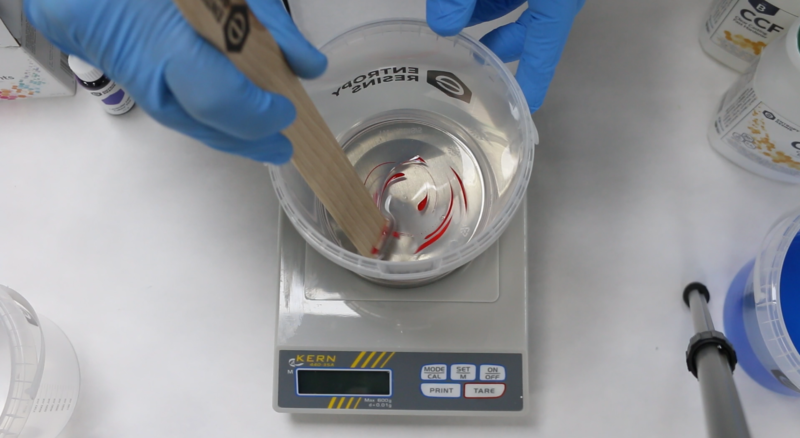
What is your best tip for avoiding bubbles in your resin creations?
Bubbles – the other big question and not just for beginners.
So initially I use my heat gun to lightly and carefully heat the epoxy to encourage the bubbles to rise to the top and pop (careful not to scorch by going too close and always keep the heat moving). In smaller items, a small blowtorch can be used. For larger items, more pro workers may use pressure pots to squeeze the bubbles to a size that can’t be seen, but this is not necessary until you are at that level – even I don’t have one.
When I work with Entropy Resins, I stir as smoothly as I can, not taking my spatula out of the epoxy (those tempting motorised mixers, they’d actually create more bubbles for a beginner, so you don’t need one) then I leave the mixed epoxy throughout the process and the bubbles rise themselves. So I stir and leave, stir and leave – and add a little heat here and there even when I’ve poured my mixed epoxy into the cups or jugs.
In moulds with depth, you will get bubbles. My tips here are to pour down the side as smoothly as you can. I often apply a little heat around the moulds at a distance and tip moulds where I can to let bubbles come out. Toothpicks are also handy for the odd stubborn, hard-to-reach bubble.
As with everything resin related it’s a trial and error and getting a feel for it. Check out this article for more tips and tricks on removing bubbles.
You can follow Kate’s journey with The Resin Reserve over on her Instagram and Facebook accounts.
Ready to give resin art a try? Interested in sustainability and doing your bit for the environment? Head over to Entropy Resins and order your first set of bio-based epoxy today.
Have you subscribed to our FREE monthly newsletter? Sign up here!
Working on a project? Share it with us! Click here…

